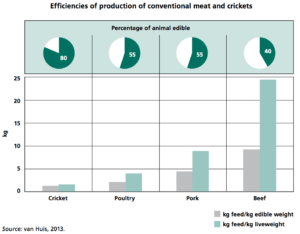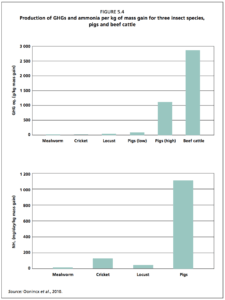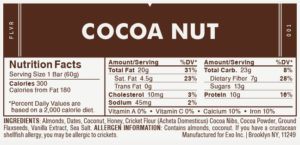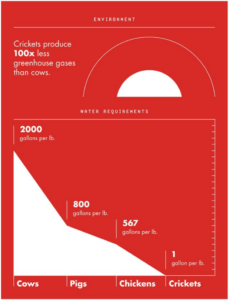Exo and the case for crickets: a small chirp in global food production

Exo uses cricket-based flour to make protein bars, bringing an innovative and sustainable approach to common food products.
As global populations and temperatures rise over the course of the coming decades, the need to sustainably and efficiently feed our planet grows as well. Entomophagy, or insect eating, may be a quirky yet simple solution to this global problem, especially in Western countries. Crickets can provide a protein-rich, efficient, and innovative food source to billions without requiring significant land use or water resources.
Shrinking glaciers, reduced snowpack, and erratic rainfall risks water supply – and therefore food supply – to key regions and up to 2 billion people.[i] According to a 2009 McKinsey study, water demand will outstrip supply by 40% by 2030.[ii] Thus, efficiently using water to produce food for human consumption is a critical objective.
Fortunately, producing crickets has many economic advantages. A key cost driver for producing livestock is animal feed. Crickets require 12 times less feed than cattle, four times less than sheep, and half as much as pigs and chickens to produce the same amount of protein (see Figure 1).[iii] Thus, on a relative basis, crickets are among the most efficient outputs of protein. Furthermore, crickets are cold-blooded and mature more quickly than livestock, further reducing total water needs over time. Finally, crickets yield more consumable food and reduce total waste: 80% of cricket yield is edible, compared to 40% of beef output (Figure 1). Crickets thus are a more efficient vehicle to deliver comparable amounts of protein at lower water and feed costs.

A related point is that crickets emit fewer greenhouse gases than livestock. The United Nations estimates place greenhouse gas emissions from livestock at up to 18% of the global emission, even more than the net emissions of transportation.[iv] Conversely, cricket production has very low greenhouse gas and ammonia emission rates (see Figure 2 below).[v] As investment in cricket production rises, technology can help cricket production to achieve zero landfill output via biodegradable processes.

These challenges provide an opportunity for private companies like Exo to make a difference in the global food supply chain. Exo’s entire business model and strategy is predicated on addressing climate change issues by creating a sustainable alternative to protein production.
Exo is a Brooklyn-based cricket-flour protein bars company with products that have no gluten, soy, dairy, or grain. Exo sells 60-gram bars with 10-grams of protein in flavors such as cocoa nut and apple cinnamon (see Figure 3).[vi] The crickets are frozen and dehydrated before being converted into powder, and each bar contains roughly ~40 crickets. Cricket-based protein, according to Exo, is a viable substitute for traditional protein, and has hired award-winning chefs such as Kyle Connaughton to introduce cricket protein to a new consumer base with “a lot of preconceived ideas that were negative.”[vii]

The company sources crickets from farms in the US and Canada, including Entomo Farms in Norwood, Ontario and All Things Bugs in Athens, Georgia.[viii] Exo’s growth has spillover effects on other companies in the supply chain in this market.
We should care about the success of companies like Exo because they are introducing a new and sustainable source of protein to Western consumers. Crickets can even have a self-sustaining production process, according to Exo cofounder Greg Sewitz: “One of the moonshot ideas we have is to use all the poop the crickets produce, which is a lot, to fertilize plants and then feed the plants back to them.”[ix] Exo has recently raised $4 million to increase its opportunities to demonstrate the value of cricket-based food products and production methods in relation to current practices. I would consider introducing cricket powder into other food products into additional packaged goods products beyond bars. Additionally, Exo can establish a leadership position in the supply chain by setting high supplier sustainability standards.
However, several barriers exist to widespread cricket consumption:
- Legislation: though farmers have bred cricket feed for 70 years, farming for human consumption is relatively new and regulations and laws do not clearly impose different standards on farming.[x] [xi]
- Taste and perception: Western diets typically do not include insects. Shifting consumer perception that insects are both good tasting and good nutrition can be costly and time-consuming.
In summary, crickets provide protein efficiently, at reduced emissions cost and lower water usage, in innovative food products to consumers in new markets, and help to create jobs. Hop on board the entomophagy train, and buy an Exo bar! From personal experience, they taste great.
(783 Words)

Sources:
[i] Harvard Business Publishing. Herderson, Rebecca M. and others. Climate Change in 2016: Implications for Business. Revised version: October 14, 2016.
[ii] McKinsey & Company. 2016. Charting our water future | McKinsey & Company . [ONLINE] Available at: http://www.mckinsey.com/business-functions/sustainability-and-resource-productivity/our-insights/charting-our-water-future. [Accessed 04 November 2016].
[iii] Food and Agricultural Organization of the United Nations. Edible Insects: future prospects for food and feed security. Available at: http://www.fao.org/docrep/018/i3253e/i3253e.pdf. Accessed November 4, 2016.
[iv] Quartz. 2016. Five reasons we should all be eating insects — Quartz. [ONLINE] Available at: http://qz.com/84127/five-reasons-we-should-all-be-eating-insects/. [Accessed 04 November 2016].
[v] Ibid, FAO report.
[vi] Bloomberg.com. 2016. Exo Cricket Protein Bars Closes Series A With Rapper Nas, Top Chef – Bloomberg. [ONLINE] Available at: http://www.bloomberg.com/news/articles/2016-03-07/exo-cricket-protein-bars-closes-series-a-with-rapper-nas-top-chef. [Accessed 04 November 2016].
[vii] Ibid.
[viii] Ibid.
[ix] Bloomberg.com. 2016. Two Young Entrepreneurs Pitch Cricket Bars for the Paleo Crowd – Bloomberg. [ONLINE] Available at: http://www.bloomberg.com/news/articles/2014-02-03/two-young-entrepreneurs-pitch-cricket-bars-for-the-paleo-crowd. [Accessed 04 November 2016].
[x] The Companies Farming Crickets for Human Consumption – The Atlantic. [ONLINE] Available at: http://www.theatlantic.com/health/archive/2015/09/americas-cricket-farmers/406843/. [Accessed 04 November 2016].
[xi] Ibid, FAO report.
Image Sources:
Figure 1: Ibid, FAO report.
Figure 2: Ibid.
Figure 3: Exo Protein Company website, www.exoprotein.com. Accessed November 4, 2016.
Figure 4: Ibid.



It’s astonishing to see how different the footprint of cricket protein is vs. the mammals we’re used to eating. You make it clear that crickets are clear winners across the board in terms of resources to produce a gram of protein. But that victory relies on comparing crickets to other animals. Pea- and soy-, and other plant-based proteins seem to be all the rage today, as do people going vegetarian or vegan in order to have a smaller dietary ecological footprint. Does Exo have to worry about competing with plant-based proteins as well? It seems like Exo could risk being outflanked by vegan proteins even if it succeeds in overcoming the taste and perception problem you mention. Or are crickets much more efficient at delivering protein than any plant could be?
Hi, Jarod!
As a big fan of protein bars, I was delighted to learn more about Exo. Even though the idea of eating cricket may, at first, sound a little odd for me, I do see myself buying this product. The sustainability appeal is indeed very interesting for this product. In addition, insect protein could be a good alternative for people who are allergic to meat alternatives like soy.
I do question what would take for western cultures to adopt it as an alternative to beef and pork meats. I guess taste is an important factor but breaking stigmas and making people more comfortable with the green idea of eating ground insects is also a turning point. I also see pricing as a challenge to overcome: until mass production, the cricket protein bars are quite expensive and, to be considered as a food for the poor and a viable replacement of beef and chicken, it must be affordable.
I think Exo’s biggest challenge will be consumer perception, as mentioned in your post. U.S. consumers tend to be naturally averse to bugs (seeing them, killing them, and especially eating them), and it will take some time for Exo and other bug-based products to make that mindset shift. I think the way to successfully change minds is to introduce crickets as a garnish vs. the main product, and then eventually introduce products that are primarily insect-based. For instance there are already “cricket tacos” served throughout the country, and the cricket taste is largely masked by all the other taco ingredients. I believe there’s a new pita chip that is coming out with a “light cricket dusting.” Hopefully over the years consumer perception of eating crickets and other bugs will shift, though it will take significant time and investment before cricket consumption is widespread vs. being a novelty.
Great read, Jared! While I love the direction Exo is going, but @APF’s comment got me thinking… @APF mentioned they were a big fan of protein bars, but protein bars don’t usually contain animal protein! So could Exo actually be creating bigger ecological footprint than traditional protein bars with plant-based proteins? To truly minimize impact should Exo look to develop a cricket-based protein to go on sandwiches, salads etc? (this sounds gross even thinking about it; I echo @WZ that consumer perception will have to change as well!)
I am impressed by the innovative idea to change human consumption of their protein, however I am very skeptical on the idea that the Western world will be able to adapt this. Not only does the company have to sell this idea based on nutritional facts but also on the basis of cost and carbon footprint. At this point in time, I still don’t think the argument is strong enough. The company will have to invest heavily in marketing the concept to people and lobby this idea politically to drive legislation and regulation. Fortunately, being on the forefront of innovative ideas, they do have the ability to pave the way to introduce this idea. It will be interesting to continue to follow this concept to see how it pans out in the future.
Jared – thank you for a tremendous read and for introducing us to entomophagy. Insects are consumed around the world, and it’s about time that the West start getting over its aversion to bugs. I grew up occasionally eating grasshoppers — they’re considered a snack in rural Mexico, readily available in markets, and they’re really not that bad.
As other commenters have noted, the main challenge for Exo will be how to convince people to get over their fear of insects. Unfortunately, I see this being a very slow transition. I think the stats here need to be broadcast far and wide — the fact that crickets require 12 times less feed than cattle to produce the same amount of protein is, I think, more than enough to get at least some people thinking about at least trying an Exo.
Yum! Jared – this post is fascinating. I had no idea how much more efficient crickets were as a source of protein vs. beef, however to echo some of the comments on this thread, I’d be keen to see how crickets stack up against soy and other plant based proteins.
This point aside, the environmental arguments seem pretty sound on crickets but my major reservation would be how to change consumer behaviours to want to purchase and eat crickets on a regular basis. Without widespread adoption and consumption, I fear crickets will become another trendy food fad that fails to catch on. This would be a real shame for the environment given the huge benefits greater consumption could offer.
Maybe the trick here would be a Vita Coco/Rihanna style partnership where a key celebrity (and ideally not a vegan one but a strong one – say Hulk Hogan) became a spokesperson for the Exo brand. A long shot perhaps, but necessary I think if crickets are to break the stigma that currently surrounds their consumption.